HISTORY OF PORT CANAVERAL: Mac McLouth Leads Port Canaveral Into Its Second Decade
By Space Coast Daily // October 31, 2014
PART TWO OF A FOUR PART SERIES

(Port Canaveral image)
EDITOR’S NOTE: This is the second of a five part series about the history of Port Canaveral. Geographically significant for centuries, and from its early days of conception as an actual inlet to the Atlantic in the 1870s, the port now plays a major role in the business and commerce of the entire region. In this second installment of a four-part series, SpaceCoastDaily.com takes a look at Port Canaveral as it sails into its second decade as the “Sleeping Giant” pushes forward, and Mac McLouth leads the Port in new directions. Environment and recreation enter the picture, increased cargo creates demand for new facilities, long-range plan for growth is commissioned and the Coast Guard sets up station.
CLICK HERE FOR PART I: Port Canaveral Culmination of Long Awaited Dream
BREVARD COUNTY • PORT CANAVERAL, FLORIDA – It was a bright sunny day in 1965 when dignitaries on the first vessel cut the ribbon at the Canaveral Lock, signaling another major milestone for the growing Port.

Port Commissioner John D’Albora chaired the ceremonial event that marked the occasion. His father’s boat, with special guest United States Senator Spessard Holland aboard, was the first vessel to navigate the waters from the Banana River channel to the ocean.
After the ceremonies, the Port Authority Commissioners and guests boarded a bus to the Cape to view the successful launch of an unmanned rocket.
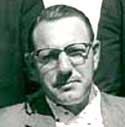
At the end of the first year, 1,470 boats, 5,992 passengers, 81 towboats and 113 barges had traveled through the Lock.
At the end of the first year, 1,470 boats, 5,992 passengers, 81 towboats and 113 barges had traveled through the Lock.
The Port began the decade with a budget of $336,000, with about a third of it coming from earned income and the rest from taxation.
By the end of 1967, revenue had jumped to $272,828 with a prediction of $450,000 for 1968. The number of ships docking had increased from 62 to 125, with 200 predicted for the next year.
Cargo had increased from 342,000 tons to 1,526,992 tons, with a prediction of 2,000,000 tons for 1968.
THE ‘SLEEPING GIANT’ PUSHES FORWARD
Called “the sleeping giant” by the Orlando Sentinel, the Port began to push marketing opportunities with a portable exhibit and attendance at industrial expos in Orlando and throughout the state. Ads were placed in conjunction with the Brevard Economic Development Council in trade publications and newspapers.
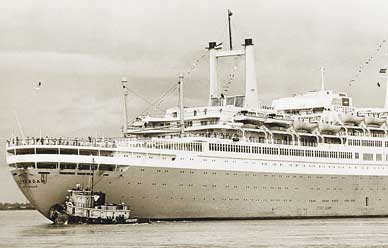
While cargo continued to be the primary thrust in marketing efforts, it was in 1967 that new Commissioner Malcolm “Mac” McLouth proposed that the authority make a pitch to Central Florida’s brand new Walt Disney World as its “outlet to the sea” for both goods and people.
That year, Holland America’s S/S Rotterdam had docked to embark passengers for a chartered cruise. The first cruise ship to sail from the Port had been four years earlier when the S/S Yarmouth boarded 402 passengers for a sold-out cruise to Nassau over Labor Day weekend 1963.

Even though regular cruises operating from the Port were only a dream for the distant future, in 1972 the Authority authorized the construction of a freight/passenger terminal.
With marketing-minded McLouth leading the way, he said, “We must let the industry know we are interested in cruise business.”
McLOUTH LEADS THE PORT IN NEW DIRECTIONS
McLouth, now Executive Director of the Port, has spent more than half his life helping develop Port Canaveral. He was the first Republican elected to the Port Authority and he brought a new perspective to the Board.
His first encounter with the Port was in 1966, while he was serving as a Boy Scout leader. He went on a weekend camping trip with his troupe to Jetty Park, which had recently opened.
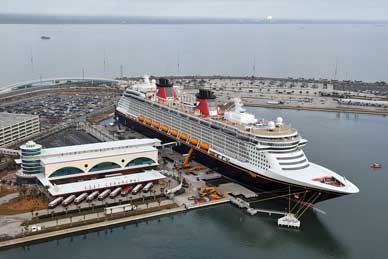
“We pitched our pup tents,” he said, “and I remember being so impressed with the beauty and serenity of the place. Being an engineer and working as I did in growth and development, I thought it would be wonderful if we could find a way to ensure that this place could escape development and always be kept as a park for people to use.”
A couple of months later he was involved in politics and was looking for people from his party to run for office in the county, “no mean feat,” he said, “for a Republican back then.”
He couldn’t find anybody to run for Port Commissioner, so, remembering that Jetty Park weekend, he decided to do it himself. At first, he said, he thought he’d just file to run for the post and sit back and see what happened. But then he began to go to the Port Authority meetings prior to the election and saw the potential there.
“I got hooked on the place,” he said, “so I campaigned hard because I wanted to get on that Board and make a difference.”
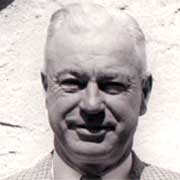
George King was a hard man to get to know, McLouth said, “but he won me over and I won him over, and together we began to market the Port. King knew the business inside out and he wanted to see it grow. He had great vision and his philosophy was ‘build and they will come.’” At that time, McLouth said, the space industry totally overwhelmed the economy of the area, but King saw a similar future for the Port.
“From the outset, everyone on that Board was dedicated to seeing the Port become self-sufficient,” he said, “and politics played little part in it. Once they got accustomed to a Yankee Republican in their midst, I earned their respect and all four Democrats actually elected me Chairman for three consecutive terms, beginning in 1977.”
ABOVE VIDEO: The Disney Dream cruise ship arrives at Port Canaveral, Florida, which is now one of the busiest cruise ports in the world with more than 3 million multi-day cruise passengers per year.
ENVIRONMENTAL, RECREATION ENTERS THE PICTURE
Jetty Park, which first inspired McLouth, continued to grow. By July 1969, it had 140 campsites with water and electrical hook-ups, tables and grills. An aerial photo of the park was included in the May 1969 issue of Trailer Life magazine.
The environment became a concern as early as 1968 when the Port Authority authorized a study and follow-up report on water pollution potential at the Port, with recommendations to prevent fouling of water abutting Port land.
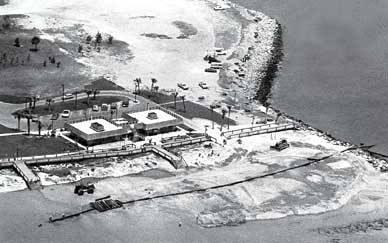
The comprehensive report included investigations of possible cost sharing opportunities with the Federal government; future dockside collections; holding and sewage disposal facilities needed; marina and industry water disposal standards; adequacy of existing laws and regulations; water purity monitoring programs; and oil skimming, floating trash removal needs.
“It would be wonderful if we could find a way to ensure that this place could escape development and always be kept as a park for people to use,” said McLouth.
Two years later another study was authorized of the Port’s ability to control a major ship fire, which led eventually to a fire protection agreement with the City of Cape Canaveral — the beginning of a long and mutually beneficial relationship between the two entities.
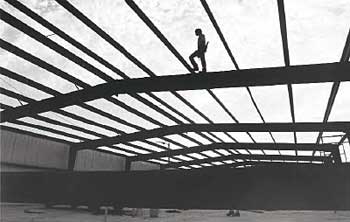
INCREASED CARGO CREATES DEMAND FOR NEW FACILITIES
Facilities were expanded during the decade to meet the demands of a burgeoning cargo industry.
Newsprint had become a major import and the Port was fast running out of space to store it. In addition, in April 1966, a tornado had severely damaged a warehouse and some of the newsprint stored there. So Manager King was authorized to prepare specifications for a new warehouse, which was built for a cost of $245,594.
LONG-RANGE PLAN FOR GROWTH IS COMMISSIONED
It was also in 1966 that the Commissioners realized the need for long-range planning and commissioned the Frederic R. Harris Company of New York to develop a long-range economic study for Port Canaveral.
The comprehensive study ran to more than one hundred pages and examined the economic base of Central Florida as well as the competition posed by other Florida Ports.
The report noted that the 25 ports in Florida represented an important industry, following tourism, agriculture and manufacturing, as one of the ranking job providers in the state.
It went on to say, “Port Canaveral itself will handle increasing volumes of commerce, primarily receipts, but with increased possibilities for coastal and foreign shipments as the general economy of the tributary area grows.”
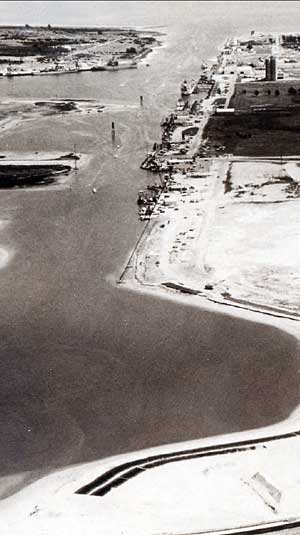
Recommendations for commodities deserving of continued marketing emphasis were petroleum products, cement and masonry, citrus, newsprint and steel. Waterfront utilization was termed a “knotty” problem.
“The Port has a limited amount of water frontage within which the commission must endeavor to accommodate many requests,” the report stated.
“Simultaneously, the commission also must continue to concern itself with the necessity for preserving Port land for future essential installations as well as for waterborne commerce oriented industries. . . [therefore] it is recommended that the master development plans indicate only certain waterfront areas for non-deep water usage on short term bases.
“This course of action will have the desired effect of preserving access for bona fide deep water users, until such time as volume and economic feasibility dictate development of the north side of the channel for Port use.”

COAST GUARD SETS UP STATION AT PORT
A lease was approved in January 1963 with the United States Coast Guard, and the first vessel, the Cutter Courageous, arrived in September 1971. The welcoming committee included Admiral O. R. Smeder, Commander of the Seventh Coast Guard District. The Port Authority, in a gesture of welcome, had the ship’s bell engraved marking the occasion.
Captain Thomas Stuart, the Port’s first harbormaster and chief pilot, died in February 1967 and Captain Fred Degendorf was appointed to the position.
In 1969 the Authority began taking steps to have the harbor deepened to 40 and to extend the channel westward with the construction of a second turning basin. A major event occurred in September 1972 when Ray Industries sought to purchase land on the barge canal for Sea Ray Boats.
The company planned a $2 million investment and the Port’s attorney, Ed Jackson, was asked to get the Port’s land appraised.
A small group of people, opposed to the Port’s expansion, managed to get the County Prosecuting Attorney to file Sunshine Law violations against three commissioners and Jackson because they refused to identify the name of the appraiser.
The four men were indicted by a grand jury, but the presiding judge in the case, after reviewing the facts, dismissed the charges as frivolous.
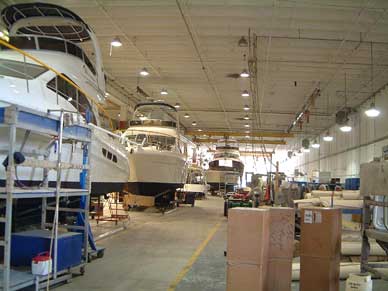
Jackson had only recently become the Port’s attorney, taking over the duties from his father, J. J. Jackson. “When this thing happened,” says the younger Jackson (now a retired judge), “my dad said, ‘Well, son, you’ve only been their attorney for a year and you’ve managed to get most of them indicted.’”
In a more serious vein, Jackson continued, “The Port has been fortunate to have good, honest businessmen guiding it through all of its 50 years, and it also has been fortunate to have a legislative delegation that has been very supportive of its needs.”
Jane Clendinen Roberts, daughter of Port Commissioner James Clendinen, echoes Jackson’s statement.
“My Dad always said political differences were put aside by the commissioners because they were so dedicated to the Port and motivated by its needs.”
She has memories of Sunshine Law problems herself when, on one occasion, several of the Commissioners were criticized for getting together for a picnic lunch on the breaker walls prior to a meeting.
“My dad was furious at the pettiness” she says, “so he painted a big, orange sun on the side of an old-fashioned lunch pail and took that and his fishing pole out to the jetties for the next lunch gathering. That way he could say he was always operating in the sunshine.”
THE PORT CONTINUES TO MOVE FORWARD

With legal difficulties over, Ray Industries made their land purchase and brought major economic growth to the Port and to Brevard County.
The operating budget continued to grow and the gap between income from taxation and operating income continued to close. At the end of its first twenty years, the “Sleeping Giant” was about to rise and shine.
STAY TUNED FOR PART III: A Growing Port for a Growth Market — The Third Decade
The third installment of SpaceCoastDaily.com’s look at the history of Port Canaveral details the great changes that were ahead for Port Canaveral as it entered its third decade. The operating budget reached $1 million for the first time in 1973 and income from revenue was $400,000, nearly approaching the equal mark with tax revenue.
CLICK HERE FOR PART I: Port Canaveral Culmination of Long-Awaited Dream
(Content was derived in part from Canaveral Port Authority’s “Staying the Course”)












